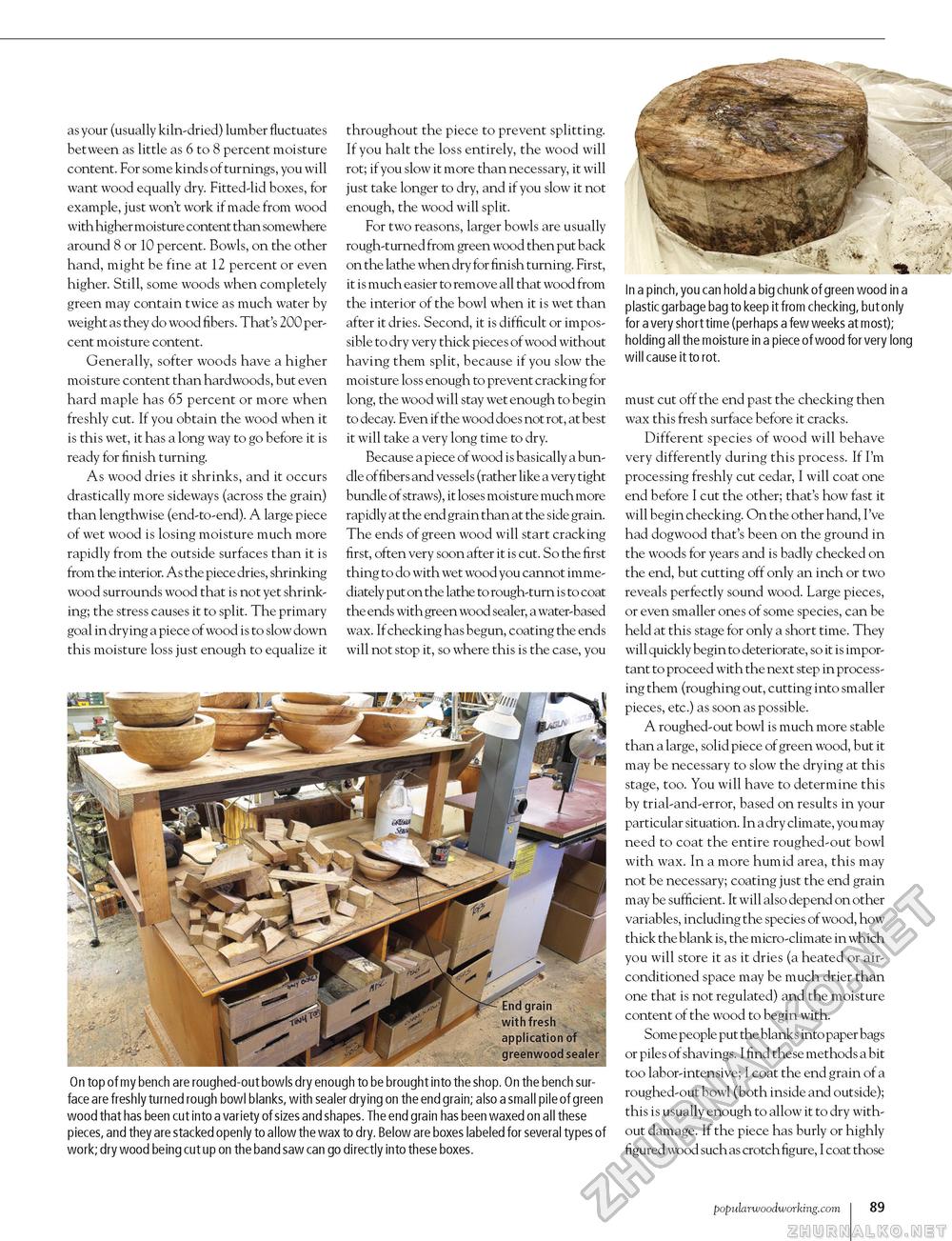Popular Woodworking 2006-02 № 153, страница 88
as your (usually kiln-dried) lumber fluctuates between as little as 6 to 8 percent moisture content. For some kinds of turnings, you will want wood equally dry. Fitted-lid boxes, for example, just won't work if made from wood with higher moisture content than somewhere around 8 or 10 percent. Bowls, on the other hand, might be fine at 12 percent or even higher. Still, some woods when completely green may contain twice as much water by weight as they do wood fibers. That's 200 percent moisture content. Generally, softer woods have a higher moisture content than hardwoods, but even hard maple has 65 percent or more when freshly cut. If you obtain the wood when it is this wet, it has a long way to go before it is ready for finish turning. As wood dries it shrinks, and it occurs drastically more sideways (across the grain) than lengthwise (end-to-end). A large piece of wet wood is losing moisture much more rapidly from the outside surfaces than it is from the interior. As the piece dries, shrinking wood surrounds wood that is not yet shrinking; the stress causes it to split. The primary goal in drying a piece of wood is to slow down this moisture loss just enough to equalize it throughout the piece to prevent splitting. If you halt the loss entirely, the wood will rot; if you slow it more than necessary, it will just take longer to dry, and if you slow it not enough, the wood will split. For two reasons, larger bowls are usually rough-turned from green wood then put back on the lathe when dry for finish turning. First, it is much easier to remove all that wood from the interior of the bowl when it is wet than after it dries. Second, it is difficult or impossible to dry very thick pieces of wood without having them split, because if you slow the moisture loss enough to prevent cracking for long, the wood will stay wet enough to begin to decay. Even if the wood does not rot, at best it will take a very long time to dry. Because a piece of wood is basically a bundle of fibers and vessels (rather like a very tight bundle of straws), it loses moisture much more rapidly at the end grain than at the side grain. The ends of green wood will start cracking first, often very soon after it is cut. So the first thing to do with wet wood you cannot immediately put on the lathe to rough-turn is to coat the ends with green wood sealer, a water-based wax. If checking has begun, coating the ends will not stop it, so where this is the case, you End grain with fresh application of greenwood sealer On top of my bench are roughed-out bowls dry enough to be brought into the shop. On the bench surface are freshly turned rough bowl blanks, with sealer drying on the end grain; also a small pile of green wood that has been cut into a variety of sizes and shapes. The end grain has been waxed on all these pieces, and they are stacked openly to allow the wax to dry. Below are boxes labeled for several types of work; dry wood being cut up on the band saw can go directly into these boxes. In a pinch, you can hold a big chunk of green wood in a plastic garbage bag to keep it from checking, but only for a very short time (perhaps a few weeks at most); holding all the moisture in a piece of wood for very long will cause it to rot. must cut off the end past the checking then wax this fresh surface before it cracks. Different species of wood will behave very differently during this process. If I'm processing freshly cut cedar, I will coat one end before I cut the other; that's how fast it will begin checking. On the other hand, I've had dogwood that's been on the ground in the woods for years and is badly checked on the end, but cutting off only an inch or two reveals perfectly sound wood. Large pieces, or even smaller ones of some species, can be held at this stage for only a short time. They will quickly begin to deteriorate, so it is important to proceed with the next step in processing them (roughing out, cutting into smaller pieces, etc.) as soon as possible. A roughed-out bowl is much more stable than a large, solid piece of green wood, but it may be necessary to slow the drying at this stage, too. You will have to determine this by trial-and-error, based on results in your particular situation. In a dry climate, you may need to coat the entire roughed-out bowl with wax. In a more humid area, this may not be necessary; coating just the end grain may be sufficient. It will also depend on other variables, including the species of wood, how thick the blank is, the micro-climate in which you will store it as it dries (a heated or air-conditioned space may be much drier than one that is not regulated) and the moisture content of the wood to begin with. Some people put the blanks into paper bags or piles of shavings. I find these methods a bit too labor-intensive; I coat the end grain of a roughed-out bowl (both inside and outside); this is usually enough to allow it to dry without damage. If the piece has burly or highly figured wood such as crotch figure, I coat those popularwoodworking.com I 103 |








